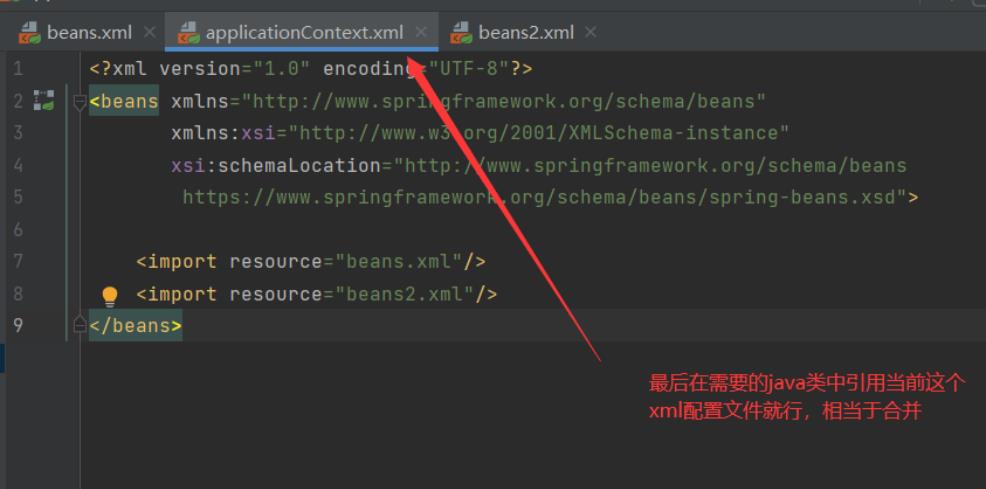Spring 控制反转(IOC)
Posted Mq_sir
tags:
篇首语:本文由小常识网(cha138.com)小编为大家整理,主要介绍了Spring 控制反转(IOC)相关的知识,希望对你有一定的参考价值。
Spring 控制反转(IOC)
IOC概念
- 控制反转,把对象创建和对象间的调用过程,交给Spring进行管理。
- 使用IOC可以降低对象间的耦合度。
- IOC底层原理:XML解析,工厂模式,反射。
上一篇博客已经详细讲解了ioc的概念和理解了。初识Spring
现在我们来讲讲 怎么使用 IOC。
一、Spring配置
详细在代码的注解里。
1、别名
<!-- 别名(给id为user取别名),如果取了别名,我们也可以通过别名获取到这个对象-->
<alias name="user" alias="aaaa"/>
2、bean的配置
Spring Ioc容器的核心就是要玩坏bean!
基本属性:
<!-- id: bean的唯一标识符
class:对象所对应的全限定名:包名+类型
name:也是别名,而且name可以起多个别名,也可以用逗号,空格,分号分隔-->
<bean id="user1" class="mq.pojo.User" name="user2,user3 user4;">
<constructor-arg name="name" value="maomao"/>
</bean>
scope属性(重点是singleton和prototype):
一般情况下是使用singleton,但是要整合struts2时则要在ActionBean中使用prototype。而request和session属性基本上是用不到的。
singleton(默认值):单例模式,所谓单例对象,就是在spring容器中只会存在一个的实例
prototype属性:多例原型被标记为多例的对象,每次再获得才会创建并且每次创建都是新的对象
request: web环境下,对象与request生命周期一致,也就是每当请求处理完一次,对象将从spring容器中移除
session:web环境下,对象与session生命周期一致
在下一篇博客会详细讲这个属性。
3、import
一般用于团队开发使用,可以将多个配置文件,导入合并成一个

使用的时候使用总配置文件就行
二、Spring IOC容器
SpringIOC的核心为IOC容器,它主要有两种:
BeanFactory:IOC容器的基本实现,是Spring内部的使用接口,不提供开发人员使用。加载配置文件的时候不会去创建对象,在获取对象使用才去创建对象。
ApplictionContext:BeanFactory接口的子接口,提供更多更强大的功能,一般有开发人员使用,加载配置文件时候就会创建对象。
ApplicationContext的实现有四种方式:
FileSystemXmlApplicationContext:加载配置文件的时候采用的是项目的路径。
ClassPathXmlApplicationContext:加载配置文件的时候根据ClassPath位置。(重点)
XmlWebApplicationContext:在Web环境下初始化监听器的时候会加载该类。
AnnotationConfigApplicationContext:根据注解的方式启动Spring 容器。(介绍)
1、依赖注入(DI)
- 依赖:bean对象的创建依赖于容器
- 注入:bean对象中的所有属性,由容器来注入
环境搭建
- 导入Spring相关的jar包
<!-- https://mvnrepository.com/artifact/org.springframework/spring-webmvc -->
<dependency>
<groupId>org.springframework</groupId>
<artifactId>spring-webmvc</artifactId>
<version>5.2.9.RELEASE</version>
</dependency>
- 编写实体类
public class Hello {
private String name;
public String getName() {
return name;
}
public void setName(String name) {
this.name = name;
}
@Override
public String toString() {
return "Hello{" +
"name='" + name + '\\'' +
'}';
}
}
构造器注入
1.无参构造创建对象(默认)
- 编写beans.xml文件(重点),spring主要就在这个文件里进行一些列的操作
有点类似Mybatis中的Mapper.xml一样,详细的在代码中有注释
<?xml version="1.0" encoding="UTF-8"?>
<beans xmlns="http://www.springframework.org/schema/beans"
xmlns:xsi="http://www.w3.org/2001/XMLSchema-instance"
xsi:schemaLocation="http://www.springframework.org/schema/beans
https://www.springframework.org/schema/beans/spring-beans.xsd">
<!-- 使用spring创建对象,在spring中这些都称为Bean
类型 变量名 = new 类型();
Hello hello =new Hello();
bean=对象 new Hello();
id=变量名 class= new 的对象
property 相当于给对象中的属性设置一个值
-->
<bean id="hello" class="mq.pojo.Hello">
<!-- value :具体的值,基本的数据类型
ref : 引用spring容器中创建好的对象-->
<property name="name" value="spring"/>
</bean>
</beans>
测试类
这里使用ClassPathXmlApplicationContext 加载配置文件,也是最常用的方式。
public class MyTest {
public static void main(String[] args) {
//获取spring的上下文对象,拿到spring的容器
ApplicationContext context = new ClassPathXmlApplicationContext("beans.xml");
//我们的对象现在都在springspring中管理,我们要使用,直接取
//getBean:参数就是spring配置文件中bean的id
Hello hello = (Hello) context.getBean("hello");
System.out.println(hello.toString());
}
}
结果:

name=spring,就是我在bean对象的时候给name属性的value值为spring
2.有参构造创建对象
我们需要在实体类中User中添加一个有参构造的方法
public class UserT {
private String name;
public UserT(String name) {
this.name = name;
}
public void setName(String name) {
this.name = name;
}
public void show(){
System.out.println("name="+ name );
}
}
编写xml配置文件
三种方式都行
-
下标赋值
<!-- 第一种,下标赋值--> <bean id="user" class="mq.pojo.User"> <constructor-arg index="0" value="maomao"/> </bean> -
通过类型来创建
<!--第二种,通过类型创建,不建议使用--> <bean id="user" class="mq.pojo.User"> <constructor-arg type="java.lang.String" value="maomao"/> </bean> -
通过参数名
<!-- 第三种,通过参数名-->
<bean id="user" class="mq.pojo.User">
<constructor-arg name="name" value="maomao"/>
</bean>
测试类:
public static void main(String[] args) {
//获取spring的上下文对象,拿到spring的容器
ApplicationContext context = new ClassPathXmlApplicationContext("beans.xml");
//我们的对象现在都在springspring中管理,我们要使用,直接取
//getBean:参数就是spring配置文件中bean的id
User user = (User) context.getBean("user");
user.show();
}
结果


小结:
在配置文件加载的时候,容器中管理的对象就已经被初始化了,也就是前面讲Spring配置的时候的单例模式,即对象就被创建了一个。
- User的对象是由Spring创建的
- User对象的属性是由bean的value设置
这个过程就是控制反转:
控制:谁来控制对象的创建,传统应用程序的对象是由程序本身控制创建的,使用Spring后,对象是由Spring IOC容器来创建和管理的.
反转:程序本身不创建对象,而变成被动的接收对象.
依赖注入:就是利用set方法来进行注入的.
IOC是一种编程思想,由主动的编程变成被动的接收.
我们彻底不用再程序中去改动代码了,要实现不同的操作,只需要在xml配置文件中进行修改,所谓的loC就是:对象由Spring来创建,管理,装配!
Set方式注入(重点)
要求被注入的属性 , 必须有set方法 , set方法的方法名由set + 属性首字母大写 ,这个例子由几乎所有属性的注入方式,有String、map、list、set、Properties、String[]、实体类(Bean的注入)对象等,如果是刚开始学的,请耐心看完beans.xml里的配置
实体类:
Address 类
public class Address {
private String address;
public String getAddress() {
return address;
}
public void setAddress(String address) {
this.address = address;
}
@Override
public String toString() {
return "Address{" +
"address='" + address + '\\'' +
'}';
}
}
Student 类
public class Student {
private String name;
private Address address;
private String[] books;
private List<String> hobbys;
private Map<String,String> card;
private Set<String> games;
private String wife;
private Properties info;
@Override
public String toString() {
return "Student{" +
"name='" + name + '\\'' +
", address=" + address.toString() +
", books=" + Arrays.toString(books) +'\\n'+
", hobbys=" + hobbys +
", card=" + card +
", games=" + games +
", wife='" + wife + '\\n' +
", info=" + info +
'}';
}
public String getName() {
return name;
}
public void setName(String name) {
this.name = name;
}
public Address getAddress() {
return address;
}
public void setAddress(Address address) {
this.address = address;
}
public String[] getBooks() {
return books;
}
public void setBooks(String[] books) {
this.books = books;
}
public List<String> getHobbys() {
return hobbys;
}
public void setHobbys(List<String> hobbys) {
this.hobbys = hobbys;
}
public Map<String, String> getCard() {
return card;
}
public void setCard(Map<String, String> card) {
this.card = card;
}
public Set<String> getGames() {
return games;
}
public void setGames(Set<String> games) {
this.games = games;
}
public String getWife() {
return wife;
}
public void setWife(String wife) {
this.wife = wife;
}
public Properties getInfo() {
return info;
}
public void setInfo(Properties info) {
this.info = info;
}
}
编写beans.xml
<?xml version="1.0" encoding="UTF-8"?>
<beans xmlns="http://www.springframework.org/schema/beans"
xmlns:xsi="http://www.w3.org/2001/XMLSchema-instance"
xmlns:context="http://www.springframework.org/schema/context"
xsi:schemaLocation="http://www.springframework.org/schema/beans
https://www.springframework.org/schema/beans/spring-beans.xsd http://www.springframework.org/schema/context https://www.springframework.org/schema/context/spring-context.xsd">
<bean id="address" class="com.mq.pojo.Address">
<property name="address" value="长沙"/>
</bean>
<bean id="student" class="com.mq.pojo.Student">
<!-- 第一种:普通值注入,value-->
<property name="name" value="小毛"/>
<!-- 第二种:Bean注入,ref-->
<property name="address" ref="address"/>
<!-- 数组注入-->
<property name="books">
<array>
<value>java教程</value>
<value>数据结构</value>
<value>C语言</value>
<value>go语言</value>
</array>
</property>
<!-- List注入-->
<property name="hobbys">
<list>
<value>听歌</value>
<value>上网</value>
<value>玩游戏</value>
<value>打篮球</value>
</list>
</property>
<!-- Map注入-->
<property name="card">
<map>
<entry key="银行卡" value="123456"/>
<entry key="银行卡2" value="123456"/>
</map>
</property>
<!-- Set注入-->
<property name="games">
<set>
<value>LOL</value>
<value>CF</value>
<value>王者荣耀</value>
</set>
</property>
<!-- null值注入-->
<property name="wife">
<null></null>
</property>
<property name="info">
<props>
<prop key="学号">20</prop>
<prop key="性别">男</prop>
<prop key="国籍">中国</prop>
</props>
</property>
</bean>
</beans>
测试类
public static void main(String[] args) {
ClassPathXmlApplicationContext context = new ClassPathXmlApplicationContext("beans.xml");
Student student = (Student) context.getBean("student");
System.out.println(student.getName());
}
结果:

拓展方式的注入
主要有p 命名空间的注入 和 c命名空间注入
实体类
public class User {
private String name;
private int age;
public User() {
}
public User(String name, int age) {
this.name = name;
this.age = age;
}
public String getName() {
return name;
}
public void setName(String name) {
this.name = name;
}
public int getAge() {
return age;
}
public void setAge(int age) {
this.age = age;
}
@Override
public String toString() {
return "User{" +
"name='" + name + '\\'' +
", age=" + age +
'}';
}
}
<!-- p 命名空间的注入,可以直接注入属性的值:property-->
<bean id="user" Spring核心(ioc控制反转)